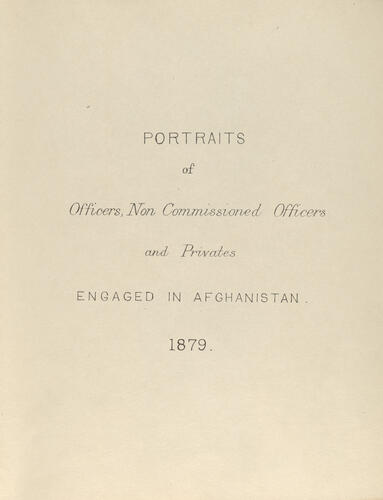-
1 of 253523 objects
Afghanistan and Egypt portraits, 1879 and 1882 c.1883
Red leather album containing mainly albumen photographs | 30.5 x 5.0 x 25.5 cm (album) | RCIN 2501413
-
Red leather album with side flaps containing photographs of soldiers who served in the Second Anglo-Afghan War (1878-80) and Anglo-Egyptian War (1882). 'AFGHANISTAN AND EGYPT PORTRAITS 1879 AND 1882' is embossed in gold on the spine and front cover. RCINs 2501414 - 2501629.
The Second Anglo-Afghan War (1878-80) was one of a series of conflicts between Britain and Russia over control of Afghanistan (known as the 'Great Game') during the nineteenth century; from the British perspective, Afghanistan was conceived of as an important strategic buffer between British India and Russian advances in Central Asia. Concerned about Russian influence in the country, the British invaded Afghanistan in 1878. The first phase of the conflict ended with the signing of the Treaty of Gandamak between the British government and Emir Yaqub Khan in May 1879; the terms of the treaty gave the British the right to a permanent embassy in Kabul and influence over Afghanistan's foreign affairs. A few months later, however, the British envoy Sir Louis Cavagnani and his entourage were killed in Kabul by Afghan troops, which led to the British reinvading. The Second Anglo-Afghan War concluded with a British victory at the Battle of Kandahar, 1 September 1880. The Third Anglo-Afghan War took place in 1919; the peace treaty with which it ended recognised the independence of Afghanistan.
The 1870s saw a period of deteriorating relations between the British Empire and Egypt amid a developing Egyptian nationalist movement discontented with external intervention in the country’s infrastructure and operation. Following riots in Alexandria on Egypt’s Mediterranean coast, where British and French naval forces were already present, in July 1882 the British launched a naval bombardment of the city and went on to seize the Suez Canal. The Suez Canal, which had opened in 1869, was of significant strategic interest to Britain as it offered a new and considerably shorter route to India. After several smaller conflicts, the Battle of Tel-el-Kebir on 13 September 1882 resulted in the British taking power in Egypt, though ostensibly it was an independent country ruled by the Khedive (Viceroy). Egypt became a British protectorate in 1914 and was then granted nominal independence by the British in 1922; the Republic of Egypt was declared in 1953.
Provenance
From the collection of Queen Victoria
-
Creator(s)
(photographer)Acquirer(s)
Subject(s)
-
Medium and techniques
Red leather album containing mainly albumen photographs
Measurements
30.5 x 5.0 x 25.5 cm (album)



